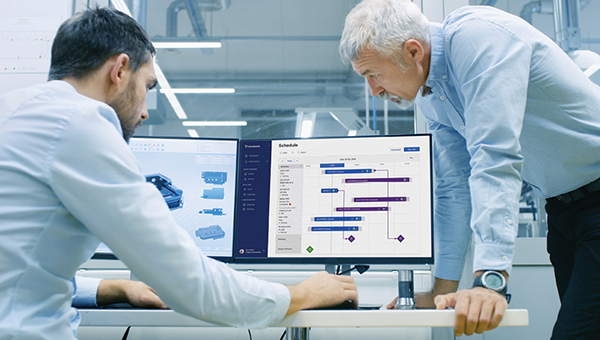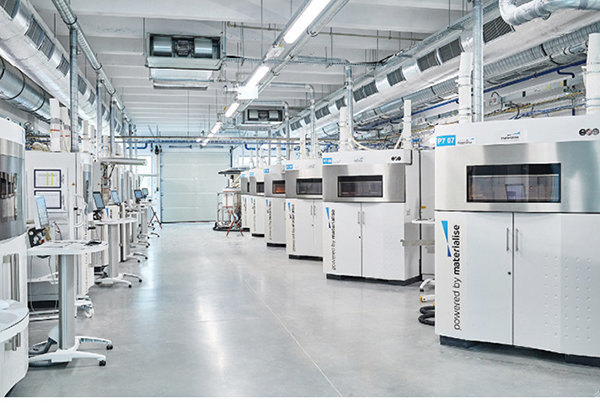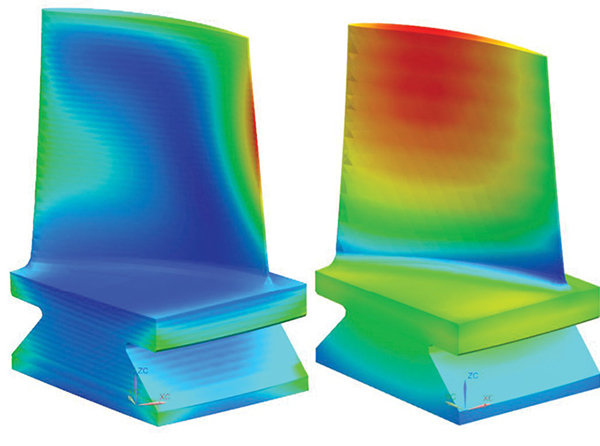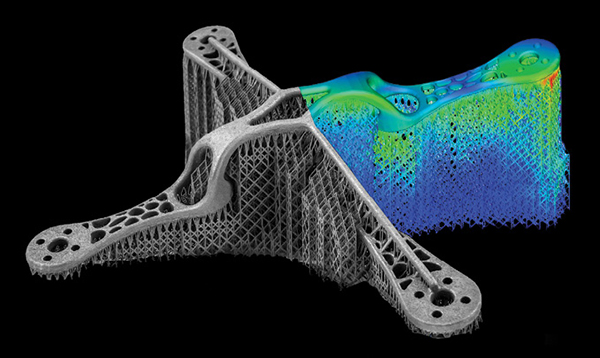Additive Manufacturing is Leaving the Island
With 3D printing growing increasingly mainstream, manufacturing execution systems are a tool against equipment downtime and production floor chaos.

Accurate and timely job scheduling may prove to be even more important to additive manufacturers than to traditional manufacturing companies. Image courtesy of 3YOURMIND.
Latest News
April 1, 2019
Walk into any manufacturing company and you’ll discover the same set of challenges: Excel spreadsheets containing critical data are stored on the local hard drives of various team members’ systems. CAD/CAM packages whose only integration to the rest of the business is a file share on the corporate server. Enterprise resource planning (ERP) systems that offer visibility to every department in the company, yet are somehow blind to the activities of the factory floor. And product lifecycle management (PLM) software that does a great job of managing product data but keeps that valuable information to itself.
Corralling the Chaos
Many manufacturers have addressed at least some of these disconnects by implementing manufacturing execution systems (MES), which serve to tie the factory’s equipment and processes to the scheduling system, the design and programming software, the PLM and ERP and overall equipment effectiveness tools that crowd the servers of manufacturers everywhere. Those who can’t afford or don’t see the need for yet another software system might hire a programmer to tie their disparate software together in hopes of an all-encompassing shop floor solution; others simply live with data disharmony, plugging along as best they can until a better solution comes along.
With 3D printing an integral part of the manufacturing landscape, however, the “let’s live with it” approach is quickly becoming untenable. What appears at first glance to be a single step, black box process is actually full of discrete operations and data collection opportunities, including print preparation, build simulation, real-time monitoring and analysis, scheduling across multiple machines and facilities, and post-processing requirements.
“With the additive manufacturing market expected to grow by up to 30% annually for the foreseeable future, integration between the equipment and various software systems is a must-have,” says Tim Van den Bogaert, market director of Materialise NV’s software division. “Additive manufacturing has specific needs and specific challenges, and if you are truly going to embrace it as a manufacturing technology, it must not operate as an isolated silo.”
Solving the Pain Points
Fortunately, Materialise and other software providers are addressing this need by redefining traditional MES in favor of software products that manage every aspect of the 3D printing workflow. For example, Autodesk is collaborating with additive manufacturing automation provider Authentise to ease the handoff between design and execution. “One of the things that we as a company have observed with additive manufacturing is that it often has a very fragmented workflow, with multiple software packages, multiple data formats and a generally inefficient process,” says Robert Yancey, Autodesk’s director of manufacturing industry strategy.

Yancey notes that Autodesk has improved a big chunk of that process with its Netfabb additive manufacturing and design software. Additionally, Authentise has developed a planning system specifically for 3D printing, which allows shops to schedule, monitor and manage every part of the additive manufacturing workflow. The challenge, though, is what happens when the “as-designed” print job needs to be changed on the production floor?
“You might need to edit the file after it [has] been released to manufacturing,” Yancey says. “The part design may need to be changed, the orientation or nesting might have to be different to fit the build chamber, or maybe it has to be processed on a different printer … there are any number of reasons. But because we’ve worked to integrate our two software packages, a user in their system can actually make modifications that, in the past, would need to be sent back to the print preparation software. Now, it’s all very seamless.”
Embrace the Magic
Materialise’s Van den Bogaert agrees with the importance of seamless integration. As an early adopter of additive manufacturing technology and subsequent developer of 3D printing software, Materialise and its employees have learned through challenges what it takes to be successful.
“We have many different brands and types of 3D printing technologies here, each with its own proprietary format, and integrating all of that has been a bit of a hassle,” he says. “At the same time, we’ve learned that it’s very difficult to manage 3D printing production using Excel sheets and paper documents, especially as you scale upwards. You simply must have some kind of management execution system to deal with this complex environment.” It’s for this reason that Materialise developed its Streamics, Magics and other 3D printing software products, so as “to operate our own services, in our own environment, in the most flexible and versatile way possible.”
Integration is not just about improving production efficiency, or eliminating the chance of duplicate data. There’s also compliance to consider. As the aerospace, medical, and indeed any industry with detailed requirements for traceability and product quality adopt additive technology, an integrated production flow is crucial to widespread acceptance of this relatively new manufacturing process. The integration needs to start at the quoting stage and continue through to the product’s end of life.
“As one of the largest 3D print factories in the world, we continuously learn from our own production needs and use this knowledge to better meet the requirements of our software customers,” Van den Bogaert explains. “The result is a software solution that builds on our own internal experiences and that offers the flexibility and integration capabilities [for customers] to scale up production sites.”
Building Bridges
To show further acceptance of manufacturing processes, Materialise has joined the ranks of numerous other additive technology providers by opening its arms to collaboration with what were once considered competitors.

“We understand where the market is going, what’s at stake and that all of us need to help further this industry,” says Van den Bogaert. “This is why we have recently invited several leading PLM and design companies to directly interface with our systems, so that they can also contribute to making the 3D printing process as efficient as possible.”
One of these companies is Siemens PLM Software. Aaron Frankel, vice president of additive manufacturing software, says the company has developed a “broad spectrum of solutions for the additive space,” including NX, Simcenter and Mindsphere, all of which are designed to manage the manufacturing process, additive or subtractive.
“There’s a great deal of market pressure coming from companies that have invested heavily over recent years into research and development of 3D printing technology, and who are now looking very aggressively at how to take that technology out of the lab and into production,” Frankel says. “Doing so, however, will require effective ways to manage the additive manufacturing production process, including MES.”

Dave Madeley, Frankel’s colleague and senior strategist for additive and subtractive manufacturing at Siemens PLM Software’s U.K. location, elaborates: “Simply put, additive is beginning to become a mainstream technology, especially on the metals side,” he says. “I don’t think it’s so much the case that you need MES to be successful with additive, but rather that additive is becoming robust enough that we can actually use it in mainstream production. As such, we need MES to manage it, just as successful companies use MES to manage their traditional manufacturing processes—additive is no longer on an island, and now must be industrialized in order to fit in with all the other systems that surround it.”
Agile, Open and Optimized
Another software provider with its eyes on industrializing 3D printing is 3YOURMIND, which has developed its Agile MES product for managing and optimizing additive workflows. Marketing and product positioning manager Brian Crotty notes that this last part—optimization—is an important but often overlooked piece of the MES puzzle.
“For the time being at least, 98% of all 3D printing is on low-volume parts,” Crotty says. “Because of this, service bureaus in particular are often faced with building a variety of parts—often from multiple customers—in a single build. You also have the situation where jobs might be produced on multiple machines or even in multiple locations.”
In these situations, he adds, you need a way to optimize the available build space, schedule the work based on delivery dates, customer priority and machine availability, while at the same time managing all of the relevant production requirements associated with those parts. “As with any type of manufacturing, success is about achieving the most cost-effective method of parts production while assuring the best part quality possible, and a data-driven MES is a big part of that,” Crotty says.
Kip Hanson writes about all things manufacturing. You can reach him here.
More 3YOURMIND Coverage
More Autodesk Coverage
More Materialise Coverage
More Siemens Digital Industries Software Coverage
Subscribe to our FREE magazine, FREE email newsletters or both!
Latest News
Related Topics







